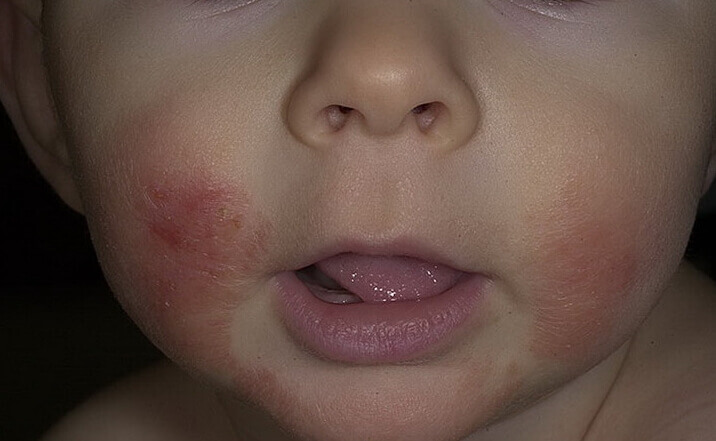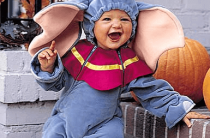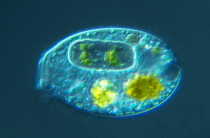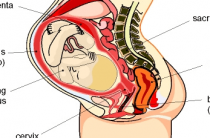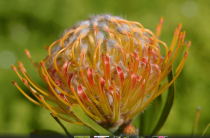This article is dedicated to one of the many diseases that very often overtakes our little children. Quite often we hear how mothers complain that a baby is suffering from diathesis, so she has to deny herself some food.
Let's take a closer look at such a problem as diathesis, find out the main causes of its occurrence, find out the symptoms characteristic of the disease, the features of treatment, and many other important points.
Signs of diathesis
Diathesis in newborns, as well as in an infant, manifests itself in 4 varieties. Consider each of the existing species in order to know what diathesis looks like.
neuro-arthritic
The first type is called neuro-arthritic. It is also sometimes called urolithiasis. It is characterized by a predisposition to the accumulation of excess fat, which in some cases leads, in fact, to obesity. Also, this type can easily provoke the development of diseases such as:
- hypertension;
- diabetes;
- gout;
- atherosclerosis.
In addition, the child can become very excited due to disorders of the nervous system, face inflammatory processes in the joints. What is the reason for this form in which diathesis can manifest itself? We will answer that only the hereditary factor plays its main role here. Note that this kind of illness in most cases worries not newborn children, but also not an infant, since it manifests itself in children of school age. Among the characteristic signs of this form of the disease are:
- anorexia;
- vomiting, enuresis;
- pain in the knees, back, which can be both sharp and aching;
- stuttering.
Allergic diathesis
This type of diathesis has another name - exudative-catarrhal (EKD). Its main characteristics are reduced resistance to all kinds of infections, as well as the frequent manifestation of allergic reactions. Often, you can see what diathesis looks like, get acquainted with this problem that worries a child, at the age of one month to six months. The so-called outbreaks of diathesis can occur throughout the year, and sometimes for two or three years. The main signs of an illness in a child are:
- whims;
- a state of anxiety;
- increase in body temperature.
The baby will usually be restless due to the sensation of severe itching, he may also refuse the bottle, mother's breast. This condition is caused not only by rashes. The baby is still worried:
- diaper rash, located in large folds, which do not go away for a very long time;
- thickening of the skin on the cheeks. (Note that these seals are caused by eczema that accompanies diathesis).
Features of allergic diathesis
You can see what this form of the disease looks like in the photo.

Now we learn about the signs of predisposition to the exudative-catarrhal type. Among the main ones are:
- excessive body weight, which does not correspond to the age of the child;
- big weight at the time of birth;
- small swelling on the skin, accompanied by pallor, poor elasticity, viscosity of the skin on palpation.
hemorrhagic
Let's find out what this type of disease looks like. Usually it is characterized by increased bleeding. Note that bleeding can be both open and closed, arising in the cavity of the tissues or organs of the baby. The cause can be caused by two factors that have occurred at the genetic level:
- the impermeability of the walls, characteristic of blood vessels, has been broken;
- or the blood has lost its ability to clot in a timely manner.
Lymphatic-hypoplastic
Now let's talk about the fourth type of disease, which is called lymphatic-hypoplastic (LHD). Often, it worries children who are prone to various infections, pathologies of the lymph nodes, allergic diseases, in addition, babies who have impaired functioning of the thymus suffer. For your information, it is the thymus that is responsible for the production of immune cells. Among the generic symptoms of this diathesis are the following:
- lack of proportionality of physique;
- overweight in a child.
With this type of diathesis, the number of immune cells significantly exceeds the norm necessary for the proper functioning of the body of babies. Any infection that appears in the body of a small child can cause an increase in the tonsils and lymph nodes. Such changes are accompanied by swelling. You can find out what such diathesis looks like by the following symptoms:
- chronic nasal congestion;
- low mobility of the child;
- enlarged submandibular lymph nodes. (Note that the increase is observed constantly).
What is the danger?
If you ignore any diathesis symptoms, the risk of acquiring problems with general development and mental abilities increases. This defect is able to develop due to hypoxia, the cause of which is a constantly stuffy nose, that is, the lack of oxygen supply to the brain of a small child in the required amount.
Causes of the disease
Diathesis is not called a disease, but a predisposition to allergic reactions, transmitted through the genetic line from the parents of the crumbs. Against the background of this baby, other serious ailments are often disturbed. A striking example of this is convulsive syndromes, infections that affect the respiratory tract, etc. Risk factors for the disease include:
- poor care of a small child;
- metabolic disorder;
- wrong daily routine;
- infections that often disturb the baby;
- non-compliance with the diet for the baby, for the mother herself.
Decreased hemoglobin
Very often, the cause of the disease is a low level of hemoglobin. In this case, all actions of parents should be aimed at raising it. Pay attention to the condition of your child: if he has pale cheeks, he often refuses to eat, suffers from various diseases, consult a therapist. The doctor must give a referral for a blood test.
How to recognize diathesis?
Initially, EKD presents with a rash that resembles prickly heat. It is worth noting that the ideal care of the baby will not make it possible to reduce the amount of rash. Diathesis in newborns, in older babies is able to show its signs on the scalp. This disease has the appearance of scaly crusts that have a yellow or gray tint. Unpleasant crusts can turn into weeping formations, since lymph is released from the skin of the affected areas. This type of disease is called weeping. You can see more in this photo.
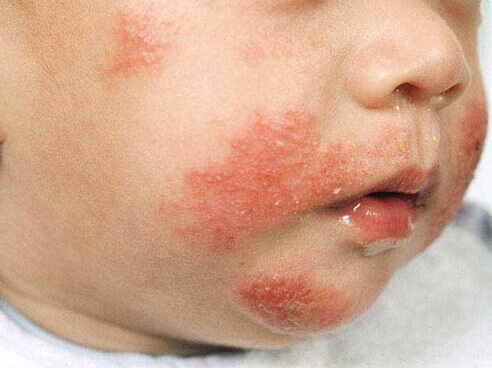
Know that a form in which there are weeping areas is a threat to the child. All sorts of infections can easily enter his body through the formed wounds, cracks. The rash affects not only the head, but spreads to the face (on the nose, chin, lips), cheeks. Usually the foci have a bright red color, are able to peel off, be weeping. Pay attention to the photo.
Affected tongue, buttocks
Rashes also appear in the buttocks. This variant of the course of the disease has its own interesting name - milk scab. Usually the rash looks pink, has a relief in the form of scaly formations. By the way, between the so-called scales, you can sometimes see the ichor in some kind of dried up or oozing state.
In addition, the rash may spread to other parts of the baby's body. Moms notice it on their arms, legs, ears, stomach. A child suffering from exudative-catarrhal diathesis, as a rule, has a specific color of the tongue. Such a language is often referred to as a "geographical language".
The marble color appears because the mucous surfaces of the crumbs are too vulnerable, which does not allow the epithelial layer of the nasal passages, the tongue, to form correctly, that is, as it should be. So, now you know what diathesis looks like. Remember, any warning signs should serve as a signal for an immediate trip to a consultation with a doctor.
Treatment
The treatment prescribed by the doctor should be directed to the use of antihistamines, a special diet, and local therapy. Initially, the mother should exclude from her diet foods that cause the development of allergies. In the same way, it is necessary to do with the diet for the child. Subsequently, new food products, dishes from them used for complementary foods, must be introduced with great care. In this case, it will be necessary to monitor the reaction of the body. Doctors advise to start food diaries for such purposes in order to clearly see the existing picture of the problem.
Of great importance is the treatment of external signs of diathesis. Gneiss that occurs on the head is recommended to be carefully processed with vegetable oil (any one that is found in the house). Then you need to take the comb, comb out as carefully as possible. To get rid of reddened spots on the cheeks, doctors advise using decoctions of various herbs that have an antiseptic effect, a solution of furacilin.
Features of therapy
Among antihistamines, such drugs will have a good effect on a small crumb:
- antihistamines (Suprastin, Fenistil);
- vitamins of groups A, E, B (except B 4, B 12);
- children who have reached 1 month are allowed to apply Bepanten to the skin.
Such a remedy will help get rid of diaper rash, reduce itching of rashes. Please note that it is applied only to the affected areas. You will learn about the rest of the features of therapy from the doctor, since he is obliged to select an individual set of therapeutic measures for each. Remember, self-treatment is a forbidden method!
Today you saw what diathesis looks like in the above photos, learned a lot of new, useful things, now you have a general idea about this disease. We look forward to your questions, feel free to ask them!
